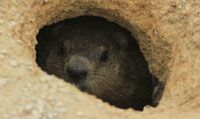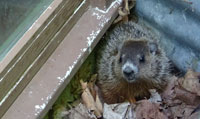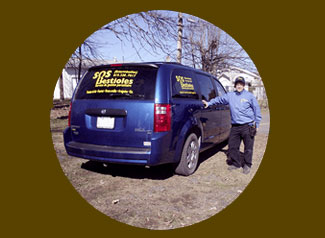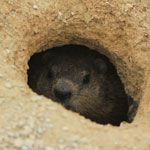How to recognize a Groundhog?
The Groundhog , Marmotta monax, is a big rodent. It is in fact our biggest squirrel. It belongs to the same family as the grey squirrel, the Sciuridae family. The Groundhog measures 45 to 75 cm long and can weight up to 7 kg (16 pounds).
The male is slightly bigger than the female. The Groundhog has a short and fatty body. Vegetarian, this rodent eats a lot of plants leaves. Its legs are short and it looks like the belly is rubbing against the ground when it walks.
The back is dark brown and the belly is lighter. Shoulders and front legs are reddish -brown. The Groundhog has an average life expectancy of 4 years.
Call an expert Ask an expert » Get a quick quote »Does the Groundhog, represent a risk for me or my belongings?
No, it is a harmless animal. The Groundhog is a peacefull, solitary and timid animal. It will run away and hide in its burrow when feels threatened. The Groundhog is herbivorous. It eats grass, flower buds, flowers and vegetables. The female Groundhog has 4-5 youngs/year, around the month of May. In order to spare youngsters, it is best to relocalize a Groundhog in March-April, before their birth.
A Groundhog can cause serious damage to your lawn, landscaping and garden, golf course. The Groundhog is a rodent and can gnaw electrical wires or water pipes if it establishes itself under a shed. It will gnaw and dig anything that is in its way. This may weaken the shed floor.
The Groundhog can damage trees when digging its burrow near them because tree roots become exposed and dry out. A Groundhog could also gnaw the wood of the balcony, deck, if it is soaked with deicing salt.
Call an expert Ask an expert » Get a quick quote »What are the signs of its presence?
The Groundhog is a diurnal mammal. It is active very early morning and in the evening, in very hot summer days. It eats grass, flowers, flower buds. It can also eat on vegetables in gardens and apples when it goes under a wild crab apple tree. The Groundhog gets onto its rear legs to check around her burrow.
 The Groundhog burrows are a good sign of its presence. The burrows are 20-25 cm in diameter and 1.5 m deep. There is a fresh dirt mound beside the burrow. A burrrow can have 2 to 5 openings, linked together by underground galleries. Around the house you can notice paths it often uses. A Groundhog can have up to 10 burrows on its feeding territory.
The Groundhog burrows are a good sign of its presence. The burrows are 20-25 cm in diameter and 1.5 m deep. There is a fresh dirt mound beside the burrow. A burrrow can have 2 to 5 openings, linked together by underground galleries. Around the house you can notice paths it often uses. A Groundhog can have up to 10 burrows on its feeding territory.
What should I do if I have a Groundhog?
 People often try to capture the Groundhog themselves but several make the problem worst by doing so. A skunk is often captured in the cage instead of the Groundhog.
People often try to capture the Groundhog themselves but several make the problem worst by doing so. A skunk is often captured in the cage instead of the Groundhog.
It takes an average of 2-4 days/Groundhog to catch. In June, there are more around because the youngsters are around with their mother. SOS Bugs will capture a Groundhog only when there is a true nuisance. There has to be damages or high risk of damage for our biologist to intervene. Our philosophy is to respect nature and help people understand better and respect the environment.
If you have problems with a Groundhog call SOS Bugs. We provide professional and trustworthy service. Our biologist will tell you if we need to intervene or not. He will give you tips to prevent their reoccurrence. If we need to capture them, we will relocalize them. Animals are our passion. Call us at 819-328-7017
Call an expert Ask an expert » Get a quick quote »


